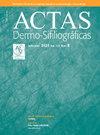揭示大疱性类天疱疮与神经系统疾病之间的联系:一项257例患者的单中心研究
IF 2.8
Q1 DERMATOLOGY
引用次数: 0
摘要
背景:多项研究证实了大疱性类天疱疮(BP)与神经系统疾病之间的关联;患有这两种疾病(BP- n)的患者预后较差,具有特定的临床和免疫学特征,从而定义了不同的BP亚型。目的:我们旨在确定BP合并神经系统合并症(BP- n)的患病率和特征,并回顾相关的已发表文献。方法:我们对2000年1月至2020年6月在一家自身免疫性水疱疾病转诊中心治疗的BP病例进行了回顾性观察研究。结果:收集了257例病例的流行病学、临床、组织病理学、进展和实验室资料,其中BP-N 102例。老年痴呆、阿尔茨海默病和血管性痴呆是最常见的神经系统合并症。BP-N患者组织嗜酸性粒细胞增多(p = 0.012),循环嗜酸性粒细胞增多(p = 0.000),抗bp180 IgG抗体增多(p = 0.007)。在收集数据时,78例BP-N死亡。结论:我们的病例系列强调了BP患者神经系统合并症的相关性;虽然其发病机制仍有待阐明,但神经退行性疾病中存在的神经炎症可以解释神经皮肤联系以及这些实体之间的时间关系。本文章由计算机程序翻译,如有差异,请以英文原文为准。
![[Artículo traducido] Penfigoide ampolloso y comorbilidad neurológica: ¿causa o consecuencia? Estudio retrospectivo unicéntrico de 257 pacientes](https://img.booksci.cn/booksciimg/2025-9/103308854891788128808.jpg)
[Artículo traducido] Penfigoide ampolloso y comorbilidad neurológica: ¿causa o consecuencia? Estudio retrospectivo unicéntrico de 257 pacientes
Background
Multiple studies have corroborated the association between bullous pemphigoid (BP) and neurological diseases; patients with both diseases (BP-N) have been associated with a worse prognosis and specific clinical and immunological characteristics, defining a different subtype of BP.
Objectives
We aimed to determine the prevalence and characteristics of BP cases with neurological comorbidities (BP-N) and review the related published literature.
Methods
We conducted a retrospective, observational study of BP cases treated at a referral center for autoimmune blistering diseases from January 2000 through June 2020.
Results
We collected epidemiological, clinical, histopathological, progression and laboratory data from a total of 257 cases, 102 of which were BP-N. Senile dementia, Alzheimer's disease and vascular dementia were the most frequent neurological comorbidities. Compared with cases without neurological comorbidities, BP-N cases had more intense tissue eosinophilia (P=.012) and higher concentrations of circulating eosinophils (P=.000), and anti-BP180 IgG antibodies (P=.007). At the time of data collection, 78 BP-N were deceased.
Conclusions
Our case series highlighted the relevance of neurological comorbidities in BP patients; although the pathogenesis is still to be elucidated, the neuroinflammation present in neurodegenerative diseases could explain the neurocutaneous link and the chronological relationship between these entities.
求助全文
通过发布文献求助,成功后即可免费获取论文全文。
去求助
来源期刊

Actas dermo-sifiliograficas
DERMATOLOGY-
CiteScore
1.90
自引率
9.40%
发文量
473
审稿时长
56 weeks
期刊介绍:
Actas Dermo-Sifiliográficas, publicación Oficial de la Academia Española de Dermatología y Venereología, es una revista de prestigio consolidado. Creada en 1909, es la revista mensual más antigua editada en España.En 2006 entró en Medline, y hoy resulta imprescindible para estar al día sobre la dermatología española y mundial.
 求助内容:
求助内容: 应助结果提醒方式:
应助结果提醒方式:


